Healthcare Networks: Security Issues and Architecture Analysis
VerifiedAdded on 2023/06/04
|13
|2674
|282
Report
AI Summary
This report provides a comprehensive overview of healthcare networks, beginning with a literature review and detailed exploration of network architecture, including devices like firewalls, servers, routers, and switches. It highlights recent developments such as cloud computing and wireless sensor networks. The report emphasizes the importance of network security in healthcare, discussing common security issues like data loss, security breaches, and malicious attacks. It offers recommendations for enhancing network security, such as the implementation of firewalls to protect against unauthorized access and malware. The report concludes by underscoring the increasing significance of modern technology in healthcare networks and the need for robust security measures to safeguard patient data and maintain the integrity of healthcare systems. The report is contributed by a student and is available on Desklib.
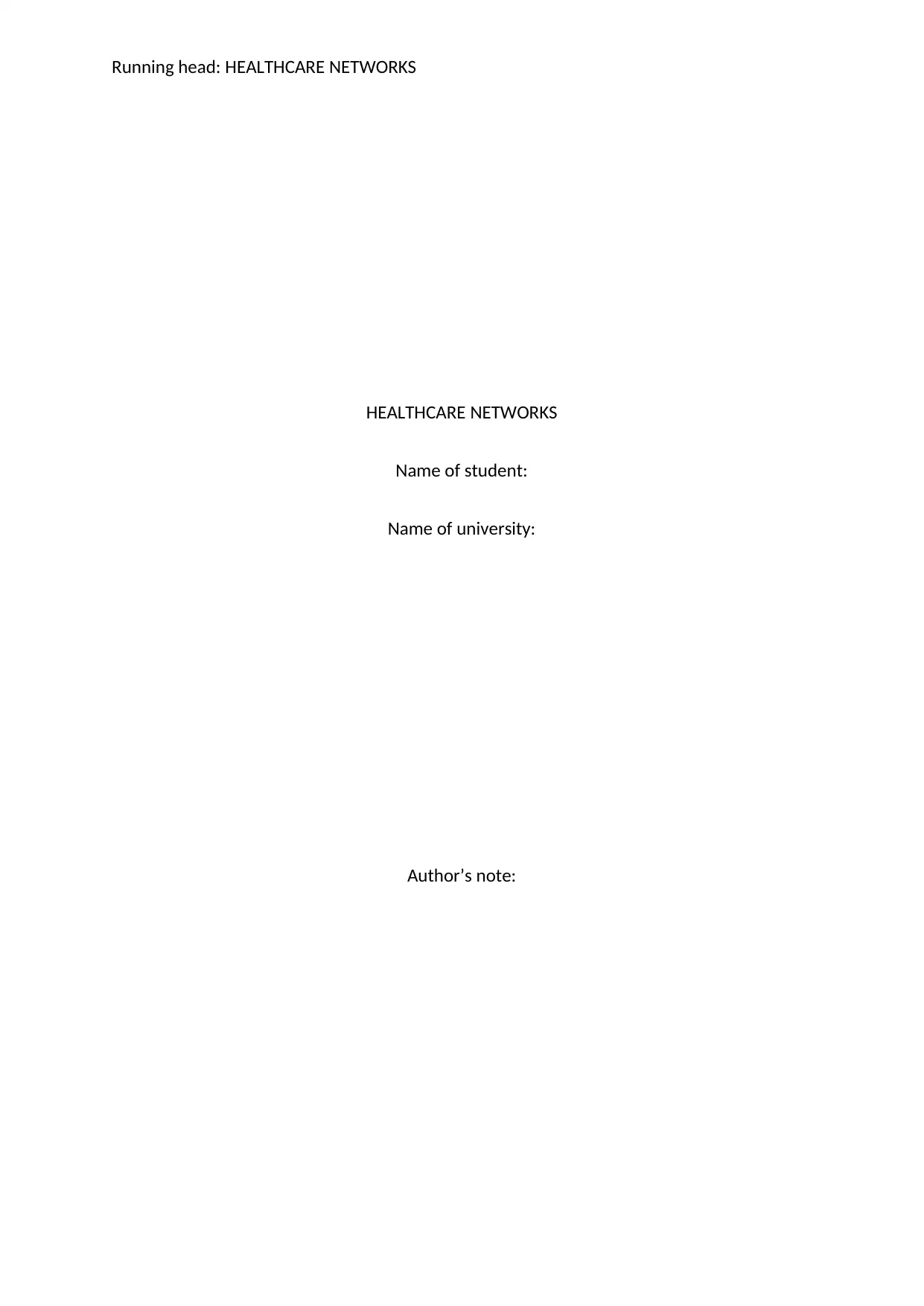
Running head: HEALTHCARE NETWORKS
HEALTHCARE NETWORKS
Name of student:
Name of university:
Author’s note:
HEALTHCARE NETWORKS
Name of student:
Name of university:
Author’s note:
Paraphrase This Document
Need a fresh take? Get an instant paraphrase of this document with our AI Paraphraser
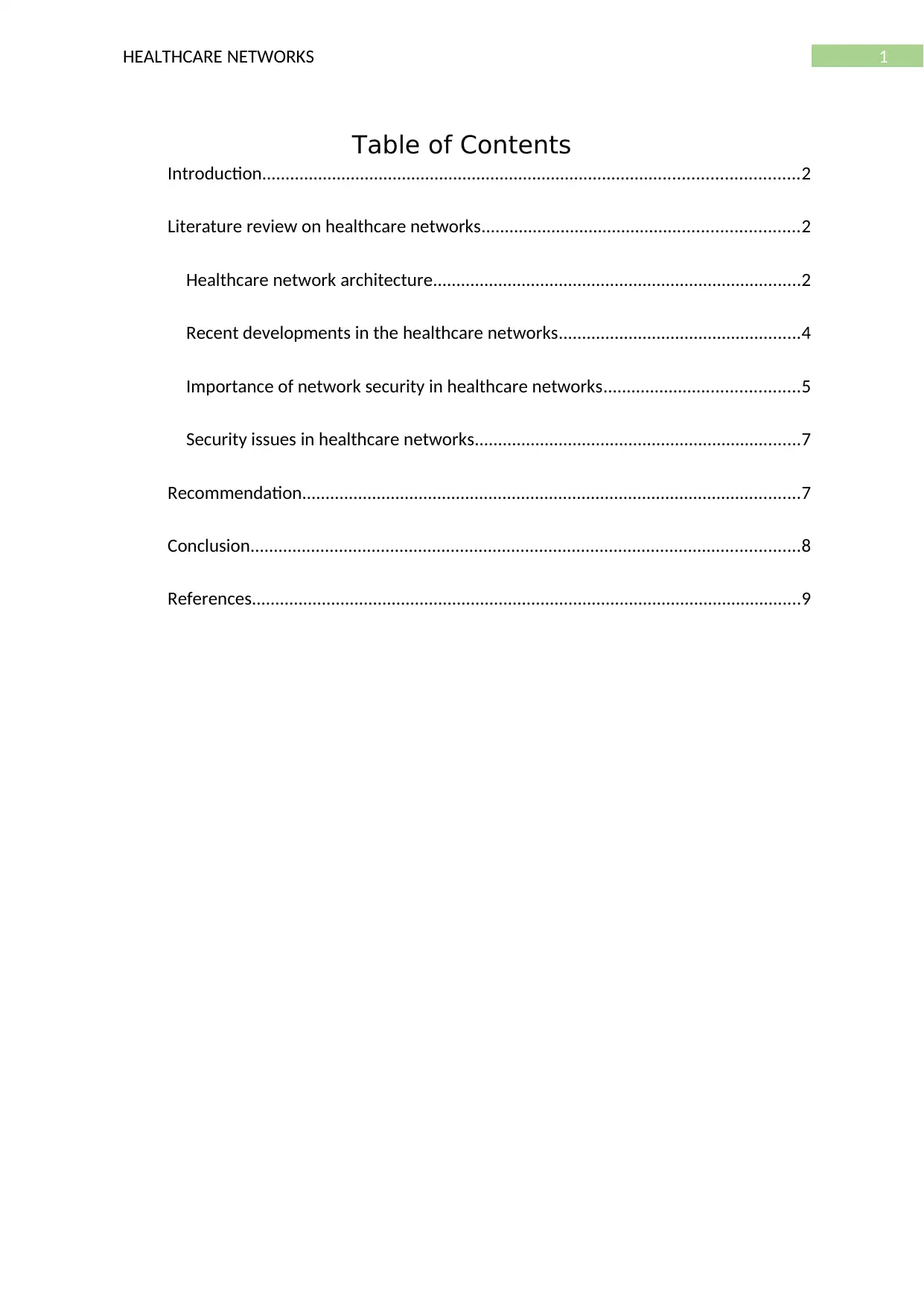
1HEALTHCARE NETWORKS
Table of Contents
Introduction...................................................................................................................2
Literature review on healthcare networks....................................................................2
Healthcare network architecture...............................................................................2
Recent developments in the healthcare networks....................................................4
Importance of network security in healthcare networks..........................................5
Security issues in healthcare networks......................................................................7
Recommendation...........................................................................................................7
Conclusion......................................................................................................................8
References......................................................................................................................9
Table of Contents
Introduction...................................................................................................................2
Literature review on healthcare networks....................................................................2
Healthcare network architecture...............................................................................2
Recent developments in the healthcare networks....................................................4
Importance of network security in healthcare networks..........................................5
Security issues in healthcare networks......................................................................7
Recommendation...........................................................................................................7
Conclusion......................................................................................................................8
References......................................................................................................................9
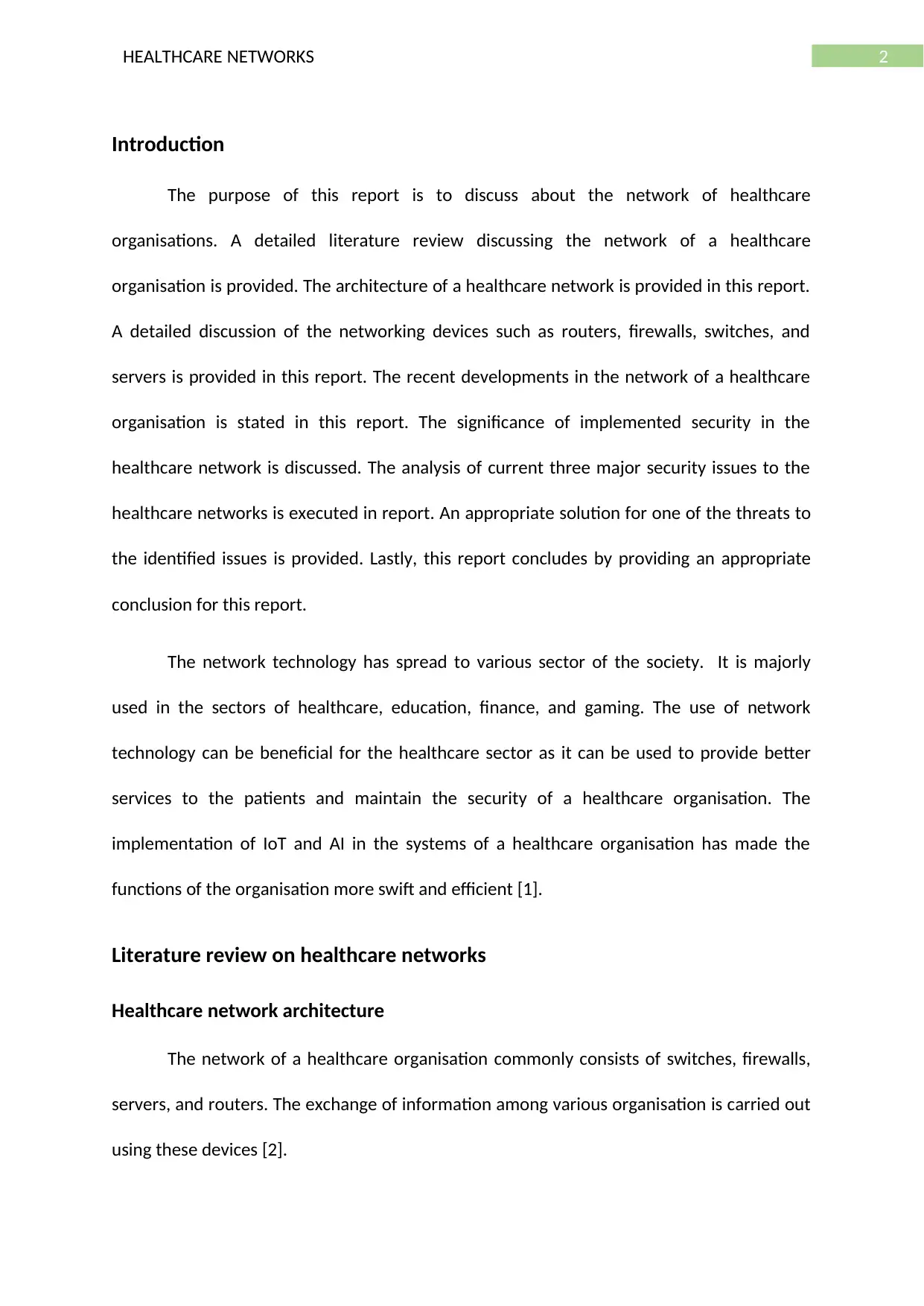
2HEALTHCARE NETWORKS
Introduction
The purpose of this report is to discuss about the network of healthcare
organisations. A detailed literature review discussing the network of a healthcare
organisation is provided. The architecture of a healthcare network is provided in this report.
A detailed discussion of the networking devices such as routers, firewalls, switches, and
servers is provided in this report. The recent developments in the network of a healthcare
organisation is stated in this report. The significance of implemented security in the
healthcare network is discussed. The analysis of current three major security issues to the
healthcare networks is executed in report. An appropriate solution for one of the threats to
the identified issues is provided. Lastly, this report concludes by providing an appropriate
conclusion for this report.
The network technology has spread to various sector of the society. It is majorly
used in the sectors of healthcare, education, finance, and gaming. The use of network
technology can be beneficial for the healthcare sector as it can be used to provide better
services to the patients and maintain the security of a healthcare organisation. The
implementation of IoT and AI in the systems of a healthcare organisation has made the
functions of the organisation more swift and efficient [1].
Literature review on healthcare networks
Healthcare network architecture
The network of a healthcare organisation commonly consists of switches, firewalls,
servers, and routers. The exchange of information among various organisation is carried out
using these devices [2].
Introduction
The purpose of this report is to discuss about the network of healthcare
organisations. A detailed literature review discussing the network of a healthcare
organisation is provided. The architecture of a healthcare network is provided in this report.
A detailed discussion of the networking devices such as routers, firewalls, switches, and
servers is provided in this report. The recent developments in the network of a healthcare
organisation is stated in this report. The significance of implemented security in the
healthcare network is discussed. The analysis of current three major security issues to the
healthcare networks is executed in report. An appropriate solution for one of the threats to
the identified issues is provided. Lastly, this report concludes by providing an appropriate
conclusion for this report.
The network technology has spread to various sector of the society. It is majorly
used in the sectors of healthcare, education, finance, and gaming. The use of network
technology can be beneficial for the healthcare sector as it can be used to provide better
services to the patients and maintain the security of a healthcare organisation. The
implementation of IoT and AI in the systems of a healthcare organisation has made the
functions of the organisation more swift and efficient [1].
Literature review on healthcare networks
Healthcare network architecture
The network of a healthcare organisation commonly consists of switches, firewalls,
servers, and routers. The exchange of information among various organisation is carried out
using these devices [2].
⊘ This is a preview!⊘
Do you want full access?
Subscribe today to unlock all pages.

Trusted by 1+ million students worldwide
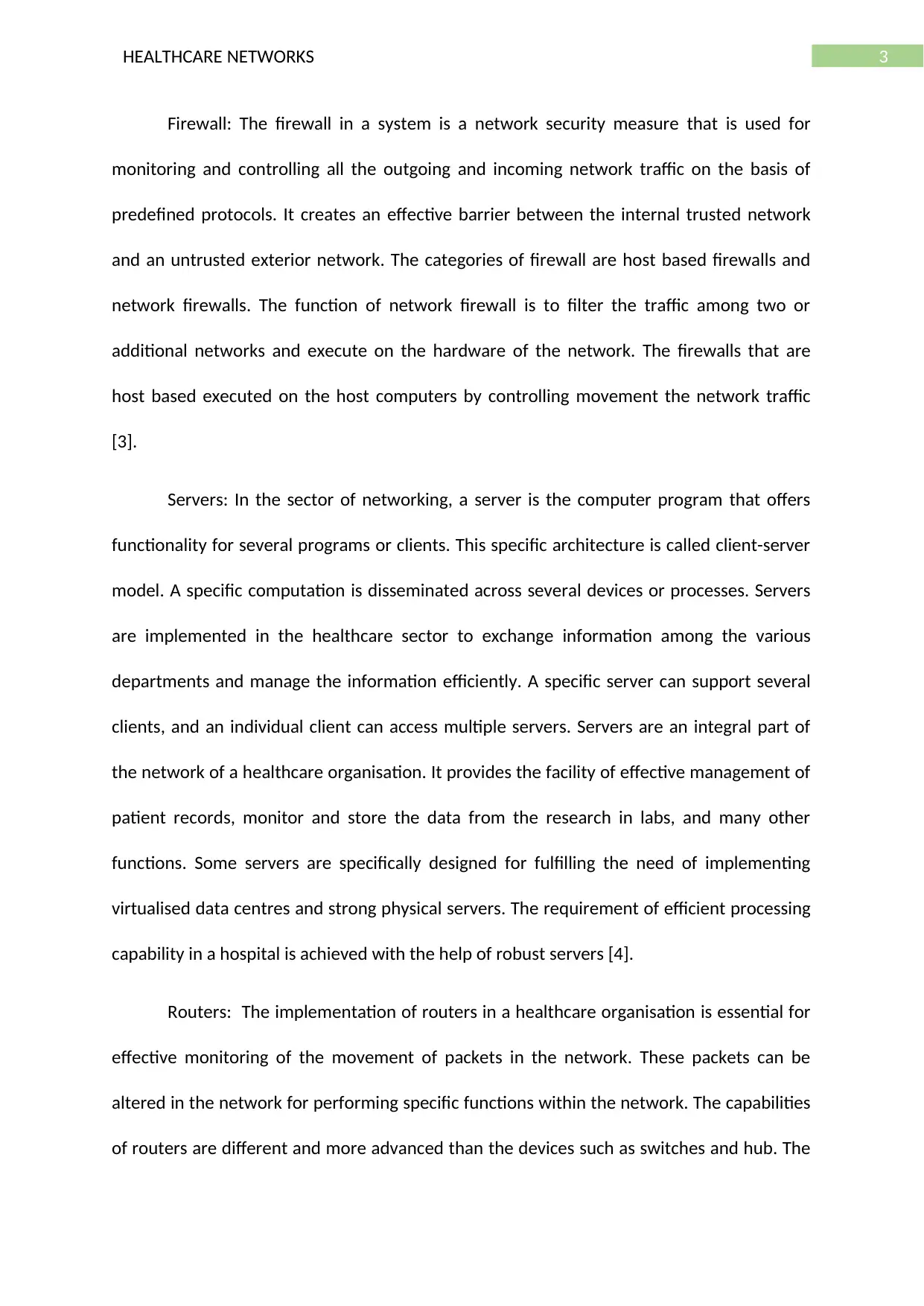
3HEALTHCARE NETWORKS
Firewall: The firewall in a system is a network security measure that is used for
monitoring and controlling all the outgoing and incoming network traffic on the basis of
predefined protocols. It creates an effective barrier between the internal trusted network
and an untrusted exterior network. The categories of firewall are host based firewalls and
network firewalls. The function of network firewall is to filter the traffic among two or
additional networks and execute on the hardware of the network. The firewalls that are
host based executed on the host computers by controlling movement the network traffic
[3].
Servers: In the sector of networking, a server is the computer program that offers
functionality for several programs or clients. This specific architecture is called client-server
model. A specific computation is disseminated across several devices or processes. Servers
are implemented in the healthcare sector to exchange information among the various
departments and manage the information efficiently. A specific server can support several
clients, and an individual client can access multiple servers. Servers are an integral part of
the network of a healthcare organisation. It provides the facility of effective management of
patient records, monitor and store the data from the research in labs, and many other
functions. Some servers are specifically designed for fulfilling the need of implementing
virtualised data centres and strong physical servers. The requirement of efficient processing
capability in a hospital is achieved with the help of robust servers [4].
Routers: The implementation of routers in a healthcare organisation is essential for
effective monitoring of the movement of packets in the network. These packets can be
altered in the network for performing specific functions within the network. The capabilities
of routers are different and more advanced than the devices such as switches and hub. The
Firewall: The firewall in a system is a network security measure that is used for
monitoring and controlling all the outgoing and incoming network traffic on the basis of
predefined protocols. It creates an effective barrier between the internal trusted network
and an untrusted exterior network. The categories of firewall are host based firewalls and
network firewalls. The function of network firewall is to filter the traffic among two or
additional networks and execute on the hardware of the network. The firewalls that are
host based executed on the host computers by controlling movement the network traffic
[3].
Servers: In the sector of networking, a server is the computer program that offers
functionality for several programs or clients. This specific architecture is called client-server
model. A specific computation is disseminated across several devices or processes. Servers
are implemented in the healthcare sector to exchange information among the various
departments and manage the information efficiently. A specific server can support several
clients, and an individual client can access multiple servers. Servers are an integral part of
the network of a healthcare organisation. It provides the facility of effective management of
patient records, monitor and store the data from the research in labs, and many other
functions. Some servers are specifically designed for fulfilling the need of implementing
virtualised data centres and strong physical servers. The requirement of efficient processing
capability in a hospital is achieved with the help of robust servers [4].
Routers: The implementation of routers in a healthcare organisation is essential for
effective monitoring of the movement of packets in the network. These packets can be
altered in the network for performing specific functions within the network. The capabilities
of routers are different and more advanced than the devices such as switches and hub. The
Paraphrase This Document
Need a fresh take? Get an instant paraphrase of this document with our AI Paraphraser
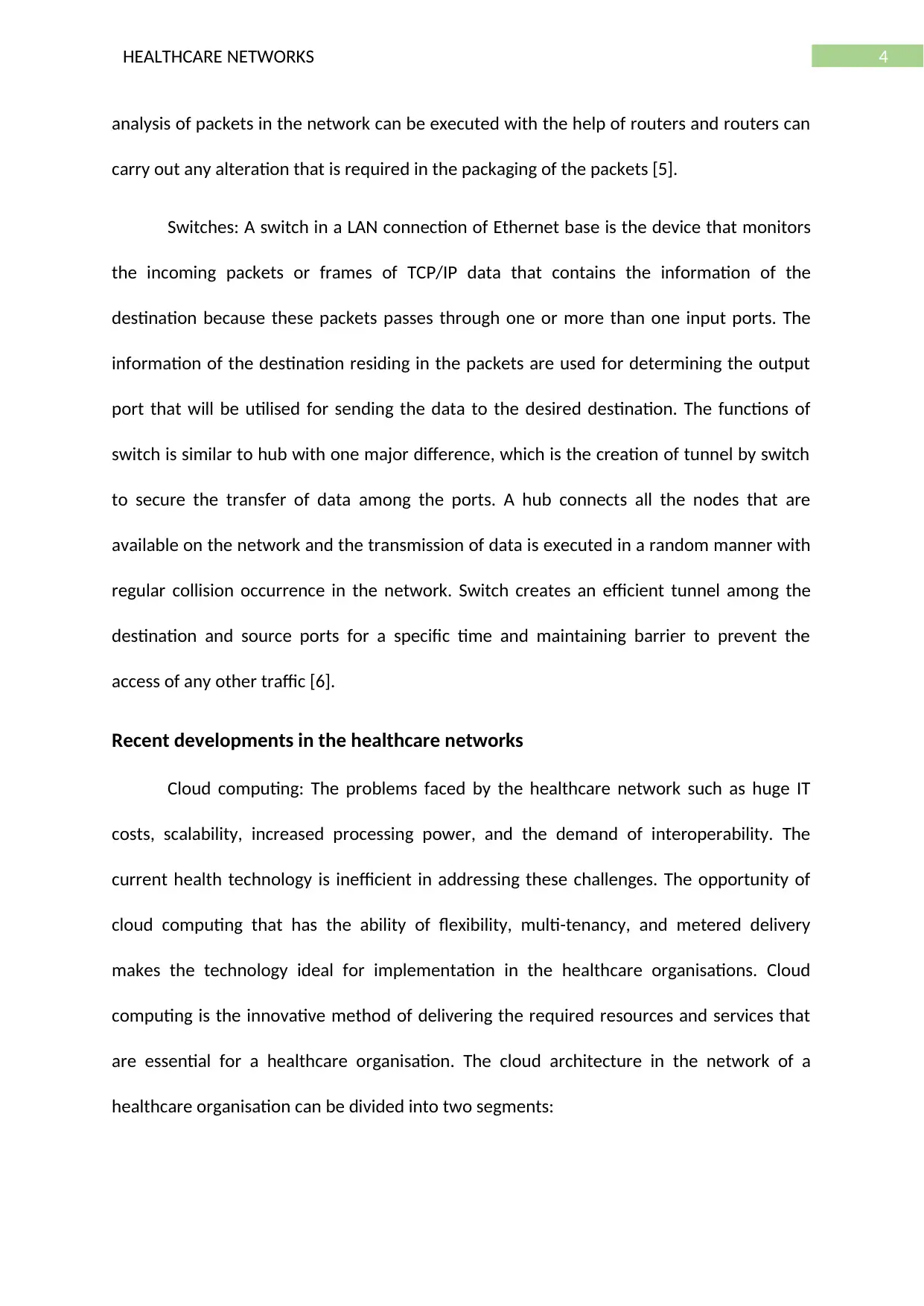
4HEALTHCARE NETWORKS
analysis of packets in the network can be executed with the help of routers and routers can
carry out any alteration that is required in the packaging of the packets [5].
Switches: A switch in a LAN connection of Ethernet base is the device that monitors
the incoming packets or frames of TCP/IP data that contains the information of the
destination because these packets passes through one or more than one input ports. The
information of the destination residing in the packets are used for determining the output
port that will be utilised for sending the data to the desired destination. The functions of
switch is similar to hub with one major difference, which is the creation of tunnel by switch
to secure the transfer of data among the ports. A hub connects all the nodes that are
available on the network and the transmission of data is executed in a random manner with
regular collision occurrence in the network. Switch creates an efficient tunnel among the
destination and source ports for a specific time and maintaining barrier to prevent the
access of any other traffic [6].
Recent developments in the healthcare networks
Cloud computing: The problems faced by the healthcare network such as huge IT
costs, scalability, increased processing power, and the demand of interoperability. The
current health technology is inefficient in addressing these challenges. The opportunity of
cloud computing that has the ability of flexibility, multi-tenancy, and metered delivery
makes the technology ideal for implementation in the healthcare organisations. Cloud
computing is the innovative method of delivering the required resources and services that
are essential for a healthcare organisation. The cloud architecture in the network of a
healthcare organisation can be divided into two segments:
analysis of packets in the network can be executed with the help of routers and routers can
carry out any alteration that is required in the packaging of the packets [5].
Switches: A switch in a LAN connection of Ethernet base is the device that monitors
the incoming packets or frames of TCP/IP data that contains the information of the
destination because these packets passes through one or more than one input ports. The
information of the destination residing in the packets are used for determining the output
port that will be utilised for sending the data to the desired destination. The functions of
switch is similar to hub with one major difference, which is the creation of tunnel by switch
to secure the transfer of data among the ports. A hub connects all the nodes that are
available on the network and the transmission of data is executed in a random manner with
regular collision occurrence in the network. Switch creates an efficient tunnel among the
destination and source ports for a specific time and maintaining barrier to prevent the
access of any other traffic [6].
Recent developments in the healthcare networks
Cloud computing: The problems faced by the healthcare network such as huge IT
costs, scalability, increased processing power, and the demand of interoperability. The
current health technology is inefficient in addressing these challenges. The opportunity of
cloud computing that has the ability of flexibility, multi-tenancy, and metered delivery
makes the technology ideal for implementation in the healthcare organisations. Cloud
computing is the innovative method of delivering the required resources and services that
are essential for a healthcare organisation. The cloud architecture in the network of a
healthcare organisation can be divided into two segments:
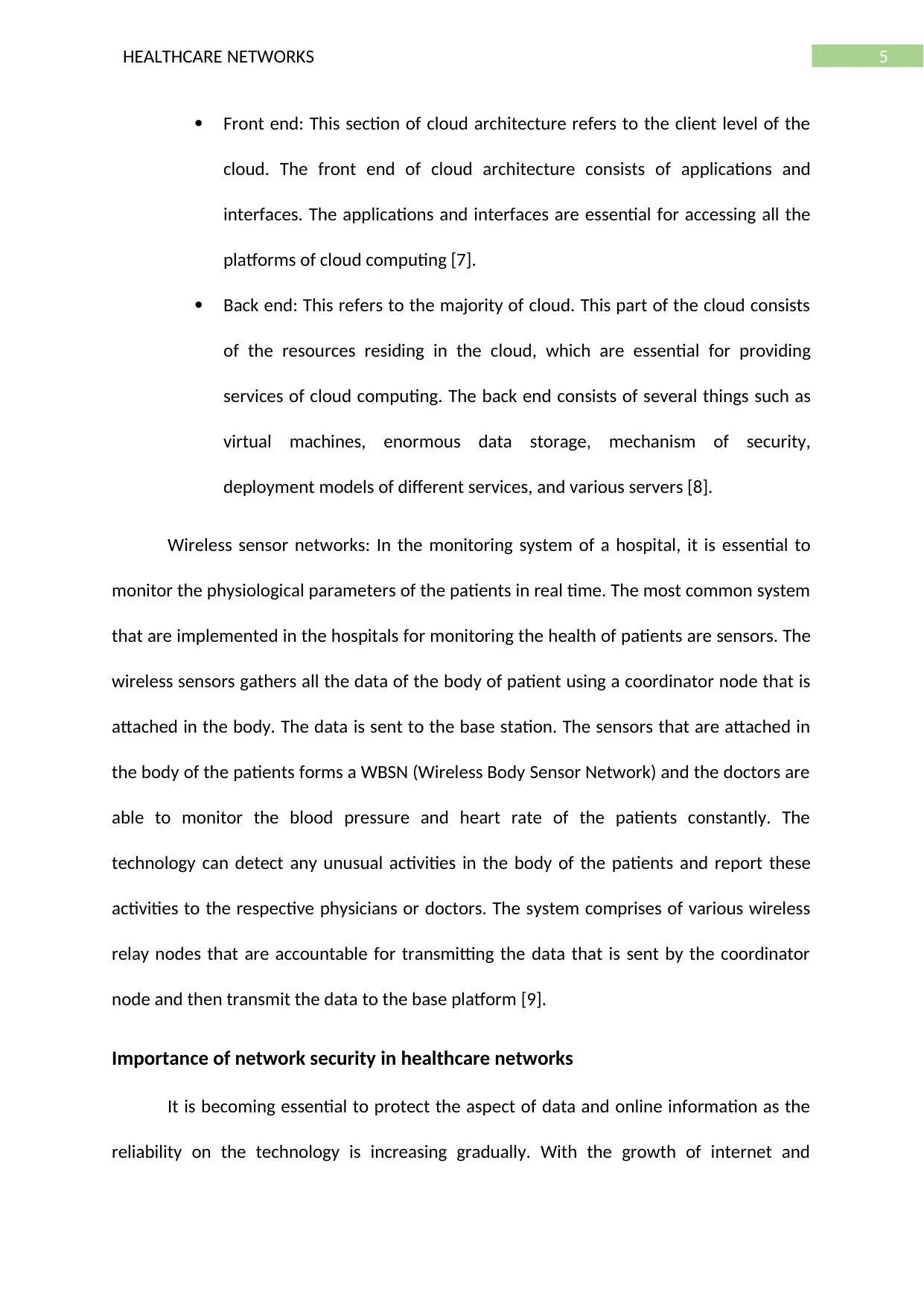
5HEALTHCARE NETWORKS
Front end: This section of cloud architecture refers to the client level of the
cloud. The front end of cloud architecture consists of applications and
interfaces. The applications and interfaces are essential for accessing all the
platforms of cloud computing [7].
Back end: This refers to the majority of cloud. This part of the cloud consists
of the resources residing in the cloud, which are essential for providing
services of cloud computing. The back end consists of several things such as
virtual machines, enormous data storage, mechanism of security,
deployment models of different services, and various servers [8].
Wireless sensor networks: In the monitoring system of a hospital, it is essential to
monitor the physiological parameters of the patients in real time. The most common system
that are implemented in the hospitals for monitoring the health of patients are sensors. The
wireless sensors gathers all the data of the body of patient using a coordinator node that is
attached in the body. The data is sent to the base station. The sensors that are attached in
the body of the patients forms a WBSN (Wireless Body Sensor Network) and the doctors are
able to monitor the blood pressure and heart rate of the patients constantly. The
technology can detect any unusual activities in the body of the patients and report these
activities to the respective physicians or doctors. The system comprises of various wireless
relay nodes that are accountable for transmitting the data that is sent by the coordinator
node and then transmit the data to the base platform [9].
Importance of network security in healthcare networks
It is becoming essential to protect the aspect of data and online information as the
reliability on the technology is increasing gradually. With the growth of internet and
Front end: This section of cloud architecture refers to the client level of the
cloud. The front end of cloud architecture consists of applications and
interfaces. The applications and interfaces are essential for accessing all the
platforms of cloud computing [7].
Back end: This refers to the majority of cloud. This part of the cloud consists
of the resources residing in the cloud, which are essential for providing
services of cloud computing. The back end consists of several things such as
virtual machines, enormous data storage, mechanism of security,
deployment models of different services, and various servers [8].
Wireless sensor networks: In the monitoring system of a hospital, it is essential to
monitor the physiological parameters of the patients in real time. The most common system
that are implemented in the hospitals for monitoring the health of patients are sensors. The
wireless sensors gathers all the data of the body of patient using a coordinator node that is
attached in the body. The data is sent to the base station. The sensors that are attached in
the body of the patients forms a WBSN (Wireless Body Sensor Network) and the doctors are
able to monitor the blood pressure and heart rate of the patients constantly. The
technology can detect any unusual activities in the body of the patients and report these
activities to the respective physicians or doctors. The system comprises of various wireless
relay nodes that are accountable for transmitting the data that is sent by the coordinator
node and then transmit the data to the base platform [9].
Importance of network security in healthcare networks
It is becoming essential to protect the aspect of data and online information as the
reliability on the technology is increasing gradually. With the growth of internet and
⊘ This is a preview!⊘
Do you want full access?
Subscribe today to unlock all pages.

Trusted by 1+ million students worldwide
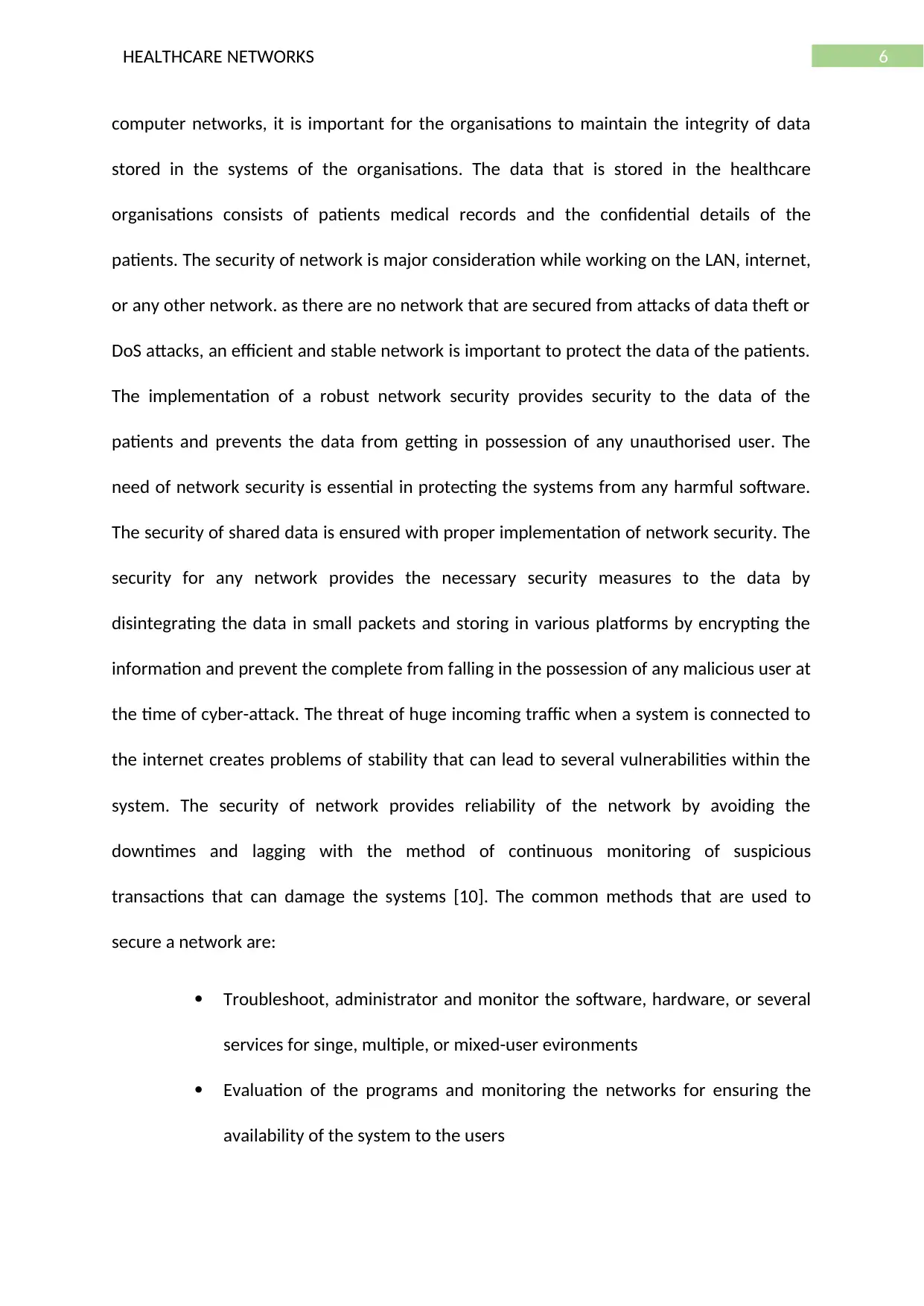
6HEALTHCARE NETWORKS
computer networks, it is important for the organisations to maintain the integrity of data
stored in the systems of the organisations. The data that is stored in the healthcare
organisations consists of patients medical records and the confidential details of the
patients. The security of network is major consideration while working on the LAN, internet,
or any other network. as there are no network that are secured from attacks of data theft or
DoS attacks, an efficient and stable network is important to protect the data of the patients.
The implementation of a robust network security provides security to the data of the
patients and prevents the data from getting in possession of any unauthorised user. The
need of network security is essential in protecting the systems from any harmful software.
The security of shared data is ensured with proper implementation of network security. The
security for any network provides the necessary security measures to the data by
disintegrating the data in small packets and storing in various platforms by encrypting the
information and prevent the complete from falling in the possession of any malicious user at
the time of cyber-attack. The threat of huge incoming traffic when a system is connected to
the internet creates problems of stability that can lead to several vulnerabilities within the
system. The security of network provides reliability of the network by avoiding the
downtimes and lagging with the method of continuous monitoring of suspicious
transactions that can damage the systems [10]. The common methods that are used to
secure a network are:
Troubleshoot, administrator and monitor the software, hardware, or several
services for singe, multiple, or mixed-user evironments
Evaluation of the programs and monitoring the networks for ensuring the
availability of the system to the users
computer networks, it is important for the organisations to maintain the integrity of data
stored in the systems of the organisations. The data that is stored in the healthcare
organisations consists of patients medical records and the confidential details of the
patients. The security of network is major consideration while working on the LAN, internet,
or any other network. as there are no network that are secured from attacks of data theft or
DoS attacks, an efficient and stable network is important to protect the data of the patients.
The implementation of a robust network security provides security to the data of the
patients and prevents the data from getting in possession of any unauthorised user. The
need of network security is essential in protecting the systems from any harmful software.
The security of shared data is ensured with proper implementation of network security. The
security for any network provides the necessary security measures to the data by
disintegrating the data in small packets and storing in various platforms by encrypting the
information and prevent the complete from falling in the possession of any malicious user at
the time of cyber-attack. The threat of huge incoming traffic when a system is connected to
the internet creates problems of stability that can lead to several vulnerabilities within the
system. The security of network provides reliability of the network by avoiding the
downtimes and lagging with the method of continuous monitoring of suspicious
transactions that can damage the systems [10]. The common methods that are used to
secure a network are:
Troubleshoot, administrator and monitor the software, hardware, or several
services for singe, multiple, or mixed-user evironments
Evaluation of the programs and monitoring the networks for ensuring the
availability of the system to the users
Paraphrase This Document
Need a fresh take? Get an instant paraphrase of this document with our AI Paraphraser
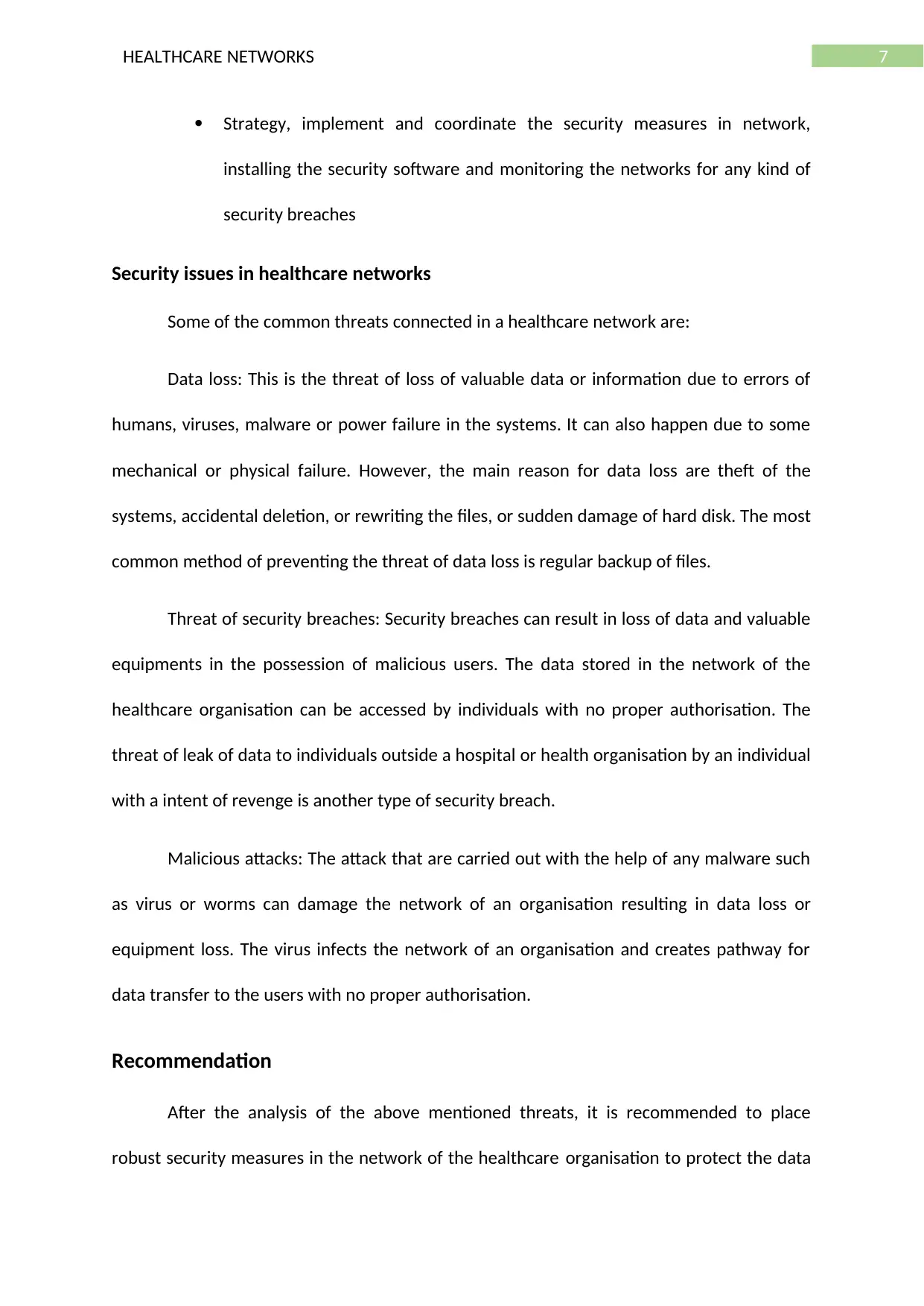
7HEALTHCARE NETWORKS
Strategy, implement and coordinate the security measures in network,
installing the security software and monitoring the networks for any kind of
security breaches
Security issues in healthcare networks
Some of the common threats connected in a healthcare network are:
Data loss: This is the threat of loss of valuable data or information due to errors of
humans, viruses, malware or power failure in the systems. It can also happen due to some
mechanical or physical failure. However, the main reason for data loss are theft of the
systems, accidental deletion, or rewriting the files, or sudden damage of hard disk. The most
common method of preventing the threat of data loss is regular backup of files.
Threat of security breaches: Security breaches can result in loss of data and valuable
equipments in the possession of malicious users. The data stored in the network of the
healthcare organisation can be accessed by individuals with no proper authorisation. The
threat of leak of data to individuals outside a hospital or health organisation by an individual
with a intent of revenge is another type of security breach.
Malicious attacks: The attack that are carried out with the help of any malware such
as virus or worms can damage the network of an organisation resulting in data loss or
equipment loss. The virus infects the network of an organisation and creates pathway for
data transfer to the users with no proper authorisation.
Recommendation
After the analysis of the above mentioned threats, it is recommended to place
robust security measures in the network of the healthcare organisation to protect the data
Strategy, implement and coordinate the security measures in network,
installing the security software and monitoring the networks for any kind of
security breaches
Security issues in healthcare networks
Some of the common threats connected in a healthcare network are:
Data loss: This is the threat of loss of valuable data or information due to errors of
humans, viruses, malware or power failure in the systems. It can also happen due to some
mechanical or physical failure. However, the main reason for data loss are theft of the
systems, accidental deletion, or rewriting the files, or sudden damage of hard disk. The most
common method of preventing the threat of data loss is regular backup of files.
Threat of security breaches: Security breaches can result in loss of data and valuable
equipments in the possession of malicious users. The data stored in the network of the
healthcare organisation can be accessed by individuals with no proper authorisation. The
threat of leak of data to individuals outside a hospital or health organisation by an individual
with a intent of revenge is another type of security breach.
Malicious attacks: The attack that are carried out with the help of any malware such
as virus or worms can damage the network of an organisation resulting in data loss or
equipment loss. The virus infects the network of an organisation and creates pathway for
data transfer to the users with no proper authorisation.
Recommendation
After the analysis of the above mentioned threats, it is recommended to place
robust security measures in the network of the healthcare organisation to protect the data
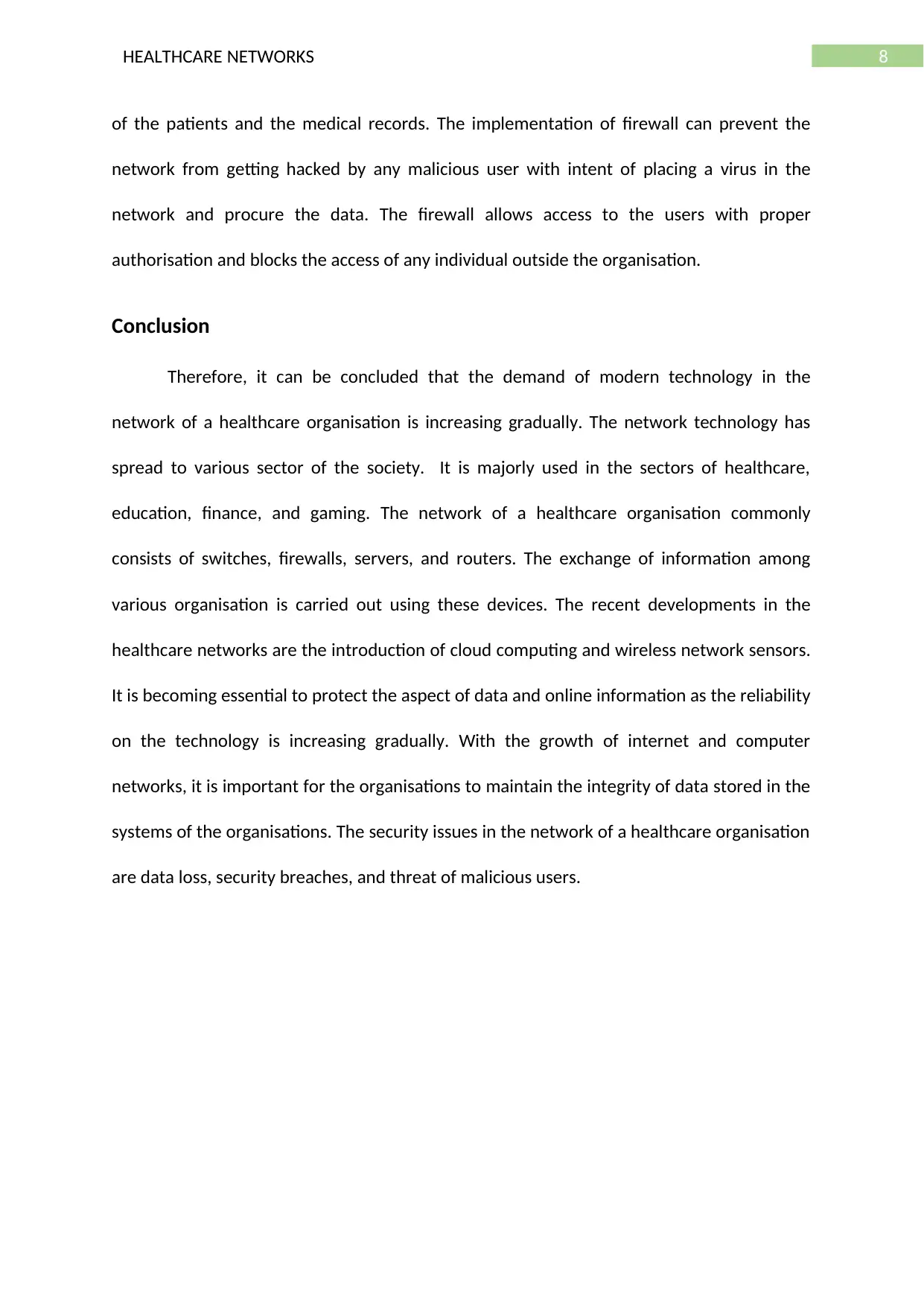
8HEALTHCARE NETWORKS
of the patients and the medical records. The implementation of firewall can prevent the
network from getting hacked by any malicious user with intent of placing a virus in the
network and procure the data. The firewall allows access to the users with proper
authorisation and blocks the access of any individual outside the organisation.
Conclusion
Therefore, it can be concluded that the demand of modern technology in the
network of a healthcare organisation is increasing gradually. The network technology has
spread to various sector of the society. It is majorly used in the sectors of healthcare,
education, finance, and gaming. The network of a healthcare organisation commonly
consists of switches, firewalls, servers, and routers. The exchange of information among
various organisation is carried out using these devices. The recent developments in the
healthcare networks are the introduction of cloud computing and wireless network sensors.
It is becoming essential to protect the aspect of data and online information as the reliability
on the technology is increasing gradually. With the growth of internet and computer
networks, it is important for the organisations to maintain the integrity of data stored in the
systems of the organisations. The security issues in the network of a healthcare organisation
are data loss, security breaches, and threat of malicious users.
of the patients and the medical records. The implementation of firewall can prevent the
network from getting hacked by any malicious user with intent of placing a virus in the
network and procure the data. The firewall allows access to the users with proper
authorisation and blocks the access of any individual outside the organisation.
Conclusion
Therefore, it can be concluded that the demand of modern technology in the
network of a healthcare organisation is increasing gradually. The network technology has
spread to various sector of the society. It is majorly used in the sectors of healthcare,
education, finance, and gaming. The network of a healthcare organisation commonly
consists of switches, firewalls, servers, and routers. The exchange of information among
various organisation is carried out using these devices. The recent developments in the
healthcare networks are the introduction of cloud computing and wireless network sensors.
It is becoming essential to protect the aspect of data and online information as the reliability
on the technology is increasing gradually. With the growth of internet and computer
networks, it is important for the organisations to maintain the integrity of data stored in the
systems of the organisations. The security issues in the network of a healthcare organisation
are data loss, security breaches, and threat of malicious users.
⊘ This is a preview!⊘
Do you want full access?
Subscribe today to unlock all pages.

Trusted by 1+ million students worldwide
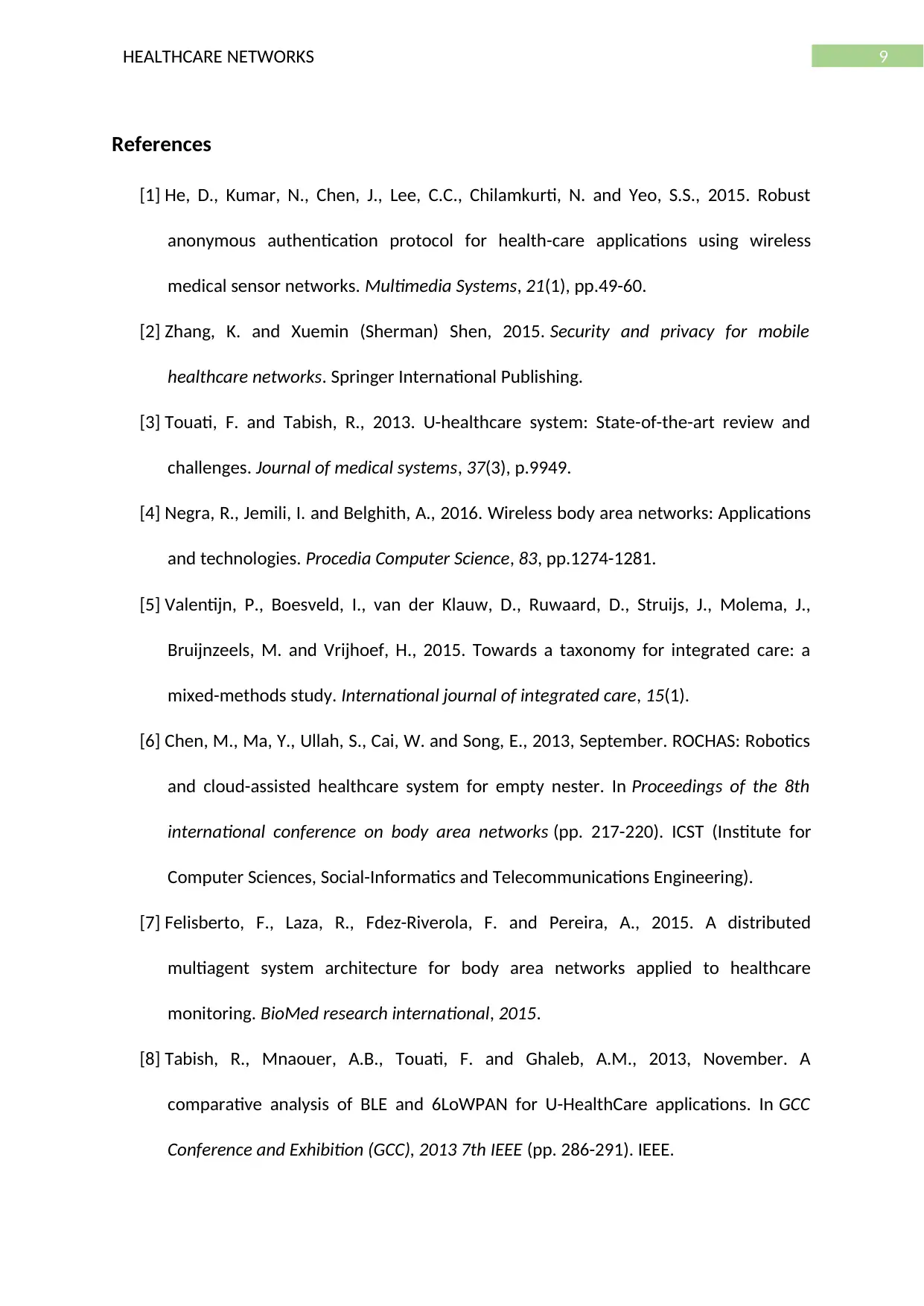
9HEALTHCARE NETWORKS
References
[1] He, D., Kumar, N., Chen, J., Lee, C.C., Chilamkurti, N. and Yeo, S.S., 2015. Robust
anonymous authentication protocol for health-care applications using wireless
medical sensor networks. Multimedia Systems, 21(1), pp.49-60.
[2] Zhang, K. and Xuemin (Sherman) Shen, 2015. Security and privacy for mobile
healthcare networks. Springer International Publishing.
[3] Touati, F. and Tabish, R., 2013. U-healthcare system: State-of-the-art review and
challenges. Journal of medical systems, 37(3), p.9949.
[4] Negra, R., Jemili, I. and Belghith, A., 2016. Wireless body area networks: Applications
and technologies. Procedia Computer Science, 83, pp.1274-1281.
[5] Valentijn, P., Boesveld, I., van der Klauw, D., Ruwaard, D., Struijs, J., Molema, J.,
Bruijnzeels, M. and Vrijhoef, H., 2015. Towards a taxonomy for integrated care: a
mixed-methods study. International journal of integrated care, 15(1).
[6] Chen, M., Ma, Y., Ullah, S., Cai, W. and Song, E., 2013, September. ROCHAS: Robotics
and cloud-assisted healthcare system for empty nester. In Proceedings of the 8th
international conference on body area networks (pp. 217-220). ICST (Institute for
Computer Sciences, Social-Informatics and Telecommunications Engineering).
[7] Felisberto, F., Laza, R., Fdez-Riverola, F. and Pereira, A., 2015. A distributed
multiagent system architecture for body area networks applied to healthcare
monitoring. BioMed research international, 2015.
[8] Tabish, R., Mnaouer, A.B., Touati, F. and Ghaleb, A.M., 2013, November. A
comparative analysis of BLE and 6LoWPAN for U-HealthCare applications. In GCC
Conference and Exhibition (GCC), 2013 7th IEEE (pp. 286-291). IEEE.
References
[1] He, D., Kumar, N., Chen, J., Lee, C.C., Chilamkurti, N. and Yeo, S.S., 2015. Robust
anonymous authentication protocol for health-care applications using wireless
medical sensor networks. Multimedia Systems, 21(1), pp.49-60.
[2] Zhang, K. and Xuemin (Sherman) Shen, 2015. Security and privacy for mobile
healthcare networks. Springer International Publishing.
[3] Touati, F. and Tabish, R., 2013. U-healthcare system: State-of-the-art review and
challenges. Journal of medical systems, 37(3), p.9949.
[4] Negra, R., Jemili, I. and Belghith, A., 2016. Wireless body area networks: Applications
and technologies. Procedia Computer Science, 83, pp.1274-1281.
[5] Valentijn, P., Boesveld, I., van der Klauw, D., Ruwaard, D., Struijs, J., Molema, J.,
Bruijnzeels, M. and Vrijhoef, H., 2015. Towards a taxonomy for integrated care: a
mixed-methods study. International journal of integrated care, 15(1).
[6] Chen, M., Ma, Y., Ullah, S., Cai, W. and Song, E., 2013, September. ROCHAS: Robotics
and cloud-assisted healthcare system for empty nester. In Proceedings of the 8th
international conference on body area networks (pp. 217-220). ICST (Institute for
Computer Sciences, Social-Informatics and Telecommunications Engineering).
[7] Felisberto, F., Laza, R., Fdez-Riverola, F. and Pereira, A., 2015. A distributed
multiagent system architecture for body area networks applied to healthcare
monitoring. BioMed research international, 2015.
[8] Tabish, R., Mnaouer, A.B., Touati, F. and Ghaleb, A.M., 2013, November. A
comparative analysis of BLE and 6LoWPAN for U-HealthCare applications. In GCC
Conference and Exhibition (GCC), 2013 7th IEEE (pp. 286-291). IEEE.
Paraphrase This Document
Need a fresh take? Get an instant paraphrase of this document with our AI Paraphraser
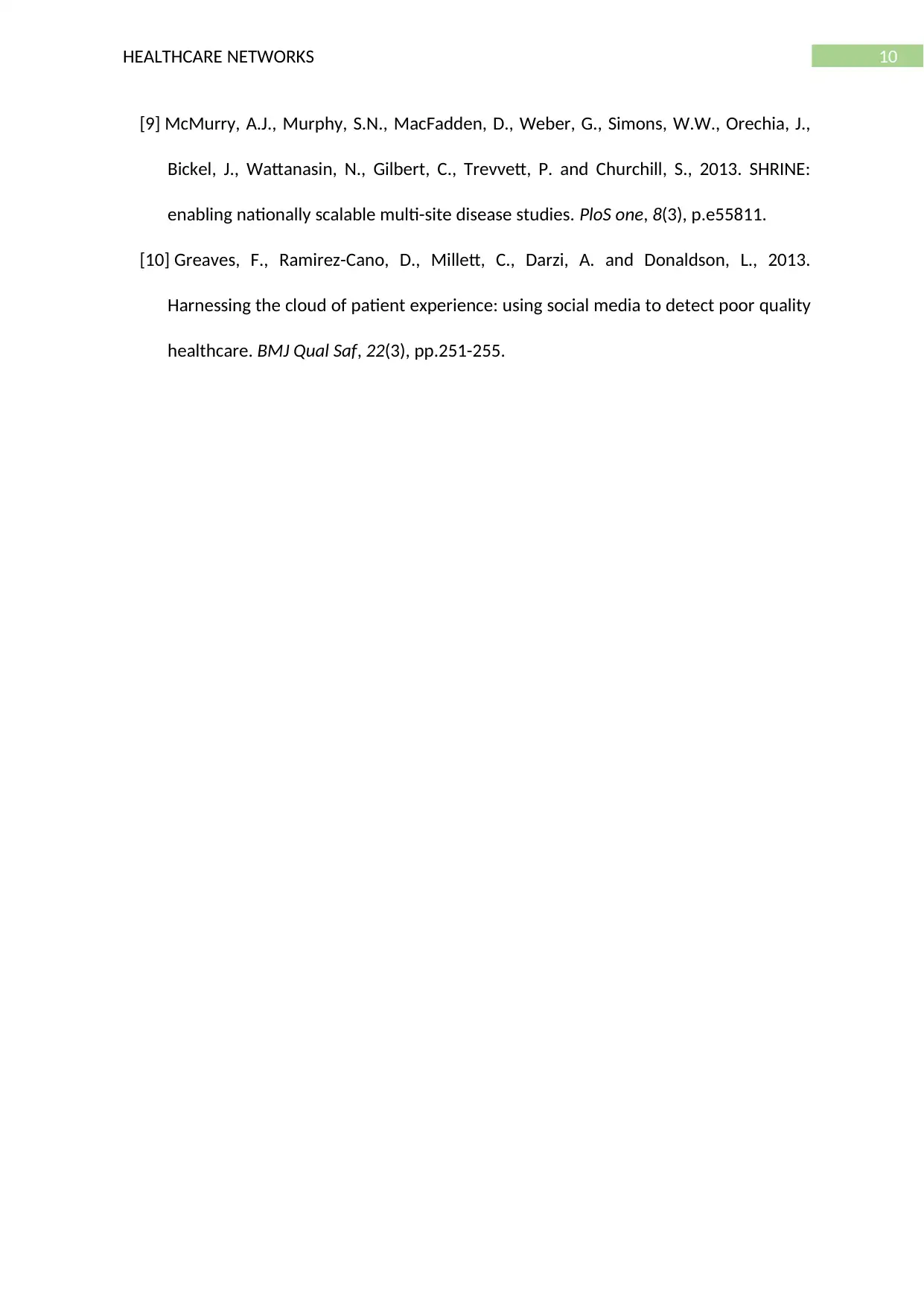
10HEALTHCARE NETWORKS
[9] McMurry, A.J., Murphy, S.N., MacFadden, D., Weber, G., Simons, W.W., Orechia, J.,
Bickel, J., Wattanasin, N., Gilbert, C., Trevvett, P. and Churchill, S., 2013. SHRINE:
enabling nationally scalable multi-site disease studies. PloS one, 8(3), p.e55811.
[10] Greaves, F., Ramirez-Cano, D., Millett, C., Darzi, A. and Donaldson, L., 2013.
Harnessing the cloud of patient experience: using social media to detect poor quality
healthcare. BMJ Qual Saf, 22(3), pp.251-255.
[9] McMurry, A.J., Murphy, S.N., MacFadden, D., Weber, G., Simons, W.W., Orechia, J.,
Bickel, J., Wattanasin, N., Gilbert, C., Trevvett, P. and Churchill, S., 2013. SHRINE:
enabling nationally scalable multi-site disease studies. PloS one, 8(3), p.e55811.
[10] Greaves, F., Ramirez-Cano, D., Millett, C., Darzi, A. and Donaldson, L., 2013.
Harnessing the cloud of patient experience: using social media to detect poor quality
healthcare. BMJ Qual Saf, 22(3), pp.251-255.

11HEALTHCARE NETWORKS
⊘ This is a preview!⊘
Do you want full access?
Subscribe today to unlock all pages.

Trusted by 1+ million students worldwide
1 out of 13
Related Documents
Your All-in-One AI-Powered Toolkit for Academic Success.
+13062052269
info@desklib.com
Available 24*7 on WhatsApp / Email
![[object Object]](/_next/static/media/star-bottom.7253800d.svg)
Unlock your academic potential
Copyright © 2020–2025 A2Z Services. All Rights Reserved. Developed and managed by ZUCOL.




